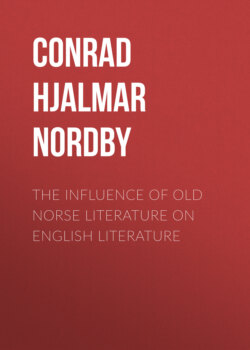Читать книгу The Influence of Old Norse Literature on English Literature - Conrad Hjalmar Nordby - Страница 5
На сайте Литреса книга снята с продажи.
THE BODY OF OLD NORSE LITERATURE.
ОглавлениеTable of Contents
First, let us understand what the Old Norse literature was that has been sending out this constantly increasing influence into the world of poetry.
It was in the last four decades of the ninth century of our era that Norsemen began to leave their own country and set up new homes in Iceland. The sixty years ending with 930 A.D. were devoted to taking up the land, and the hundred years that ensued after that date were devoted to quarreling about that land. These quarrels were the origin of the Icelandic family sagas. The year 1000 brought Christianity to the island, and the period from 1030 to 1120 were years of peace in which stories of the former time passed from mouth to mouth. The next century saw these stories take written form, and the period from 1220 to 1260 was the golden age of this literature. In 1264, Iceland passed under the rule of Norway, and a decline of literature began, extending until 1400, the end of literary production in Iceland. In the main, the authors of Iceland are unknown [2].
There are several well-marked periods, therefore, in Icelandic literary production. The earliest was devoted to poetry, Icelandic being no different from most other languages in the precedence of that form. Before the settlement of Iceland, the Norse lands were acquainted with songs about gods and champions, written in a simple verse form. The first settlers wrote down some of these, and forgot others. In the Codex Regius, preserved in the Royal Library in Copenhagen, we have a collection of these songs. This material was published in the seventeenth century as the Sæmundar Edda, and came to be known as the Elder or Poetic Edda. Both titles are misnomers, for Sæmund had nothing to do with the making of the book, and Edda is a name belonging to a book of later date and different purpose.
This work—not a product of the soil as folk-songs are—is the fountain head of Old Norse mythology, and of Old Norse heroic legends. Völuspá and Hávamál are in this collection, and other songs that tell of Odin and Baldur and Loki. The Helgi poems and the Völsung poems in their earliest forms are also here.
A second class of poetry in this ancient literature is that called "Skaldic." Some of this deals with mythical material, and some with historical material. A few of the skalds are known to us by name, because their lives were written down in later sagas. Egill Skallagrímsson, known to all readers of English and Scotch antiquities, Eyvind Skáldaspillir and Sigvat are of this group.
Poetic material that is very rich is found in Snorri Sturluson's work on Old Norse poetics, entitled The Edda, and often referred to as the Younger or Prose Edda.
More valuable than the poetry is the prose of this literature, especially the Sagas. The saga is a prose epic, characteristic of the Norse countries. It records the life of a hero, told according to fixed rules. As we have said, the sagas were based upon careers run in Iceland's stormy time. They are both mythical and historical. In the mythical group are, among others, the Völsunga Saga, the Hervarar Saga, Friðthjófs Saga and Ragnar Loðbróks Saga. In the historical group, the flowering time of which was 1200–1270, we find, for example, Egils Saga, Eyrbyggja Saga, Laxdæla Saga, Grettis Saga, Njáls Saga. A branch of the historic sagas is the Kings' Sagas, in which we find Heimskringla, the Saga of Olaf Tryggvason, the Flatey Book, and others.
This sketch does not pretend to indicate the quantity of Old Norse literature. An idea of that is obtained by considering the fact that eleven columns of the ninth edition of the Encyclopædia Britannica are devoted to recording the works of that body of writings.
